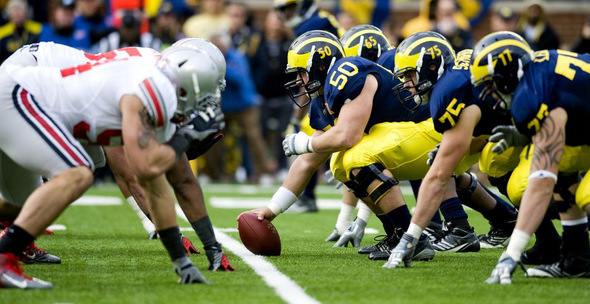Sunday, February 26, 2012
A Return to a Two Team Big Ten?
With Michigan's success under Brady Hoke and Ohio State's hiring of Urban Meyer, there's a question of whether the Big Ten will return to the Big Two and the little rest of the Big Ten (since this number has changed from 8, to 9, to 10). In his first year as head coach of Michigan, Hoke led his team to an 11-2 record including a Sugar Bowl victory. He also had a top 10 recruiting class and is well on his way to another one this year. For Urban Meyer, the expectation of success seems inevitable. In his first month and a half, he rallied Ohio State to a top 5 recruiting class. The belief is that this dominance in recruiting will translate to the gridiron.
To start, it must be said that Michigan and Ohio State's recruiting has traditionally been the best in the Big Ten. Other schools have compiled some good classes, but they haven't been consistent. With Urban Meyer and Brady Hoke entering the fold, recruiting has become more cut throat. Their pursuit of top talent is limitless, and it's going to squeeze the number of top prospects that tend to trickle down to the rest of the Big Ten. The disparity between the two and the rest of the Big Ten should grow.
Part of the problem was that Michigan has not been as competitive these last few years. Furthermore, they weren't competing for the services of the same players. Rich Rodriguez had to find players that fit his offensive system. They were recruiting different players, and as a result, the two schools didn't hold each other accountable on the recruiting trail.
While Ohio State maintained its level of recruiting for the most part, Michigan's recruiting clearly wasn't as effective. Lloyd Carr was getting top 15 classes with the average stars in the mid to high 3s. The recruiting classes under Rich Rod dropped to the low 3s. Additionally, many of the players he recruited did not stay on campus or did not see the field.
The real beneficiary of this drop off was Michigan State. The Spartans capitalized at Michigan's expense, improving their average the mid to high 2-stars to the low 3-stars. At the end of the Lloyd Carr days, Michigan State was getting only one 4/5-star every year. In the last four years, Michigan State has gotten 3 or more.
It appears that things are changing with Hoke and Meyer in the mix. Beyond the fact that both schools had top 5 classes last year, it's impressive how these two have compiled talent against their competition. Hoke has put an emphasis in getting the top players in the state of Michigan. Last year, he got 9 of the top 15 players in Michigan. Furthermore, he has already locked up 4 of the 6 players from Michigan in the early Rivals 250. He is winning a lot of head to head battles with Michigan State.
You can look at the success Urban Meyer had by looking at the players that he kept or flipped. He got Tommy Schutt, Armani Reeves, and Camren Williams to decommit from Penn State. He landed Se'Von Pittman from Michigan State, Kyle Dodson from Wisconsin, and Taylor Decker from Notre Dame. Additionally, he landed two five-star defensive ends in Noah Spence and Adolphus Washington. Not only is Urban Meyer bringing this talent to Ohio State, he is taking the talents directly away from some of their top competitors.
2013 is shaping up to be a similar story. Brady Hoke has already landed 11 players in the Rivals 250, including 6 players in the top 100. All of the players that Urban Meyer had landed are in the Rivals 250 including top 10 prospect, Cameron Burrows. No other Big Ten team has Rivals 250 commit. It's still early, but it goes to show that Hoke and Meyer will get their players and the rest of Big Ten will have to wait.
We'll need some time to see if the recruiting dominance will translate to the field. However, you can look at the records of Meyer and Hoke and anticipate that it will. This might not be a good thing for the other schools of the Big Ten, but a return to dominance for both of these schools on a national level could change the negative perception that the conference has developed in recent years.
As an alumnus of Michigan, I hope that this is the case.
Subscribe to:
Post Comments (Atom)

No comments:
Post a Comment